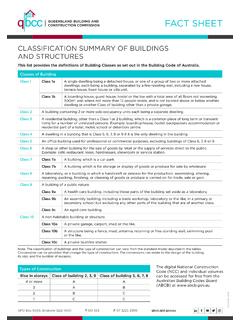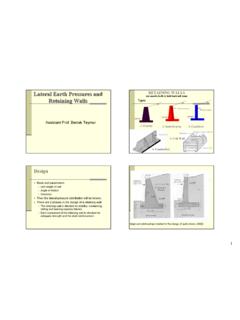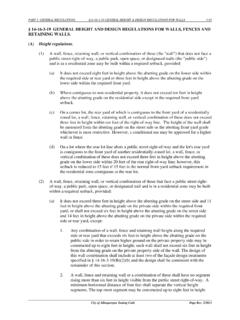Transcription of A guide to preventing structural damage
1 A guide to preventing structural damage Home owners guide to planning landscaping and maintenance of foundationsStructural damage can result from movement in clay soils caused by varying moisture conditions around the perimeter of homes. The majority of Queensland homes are situated on what are termed reactive clay soils. These soils are subject to expansion and contraction depending on seasonal weather and site conditions. Sandy sites and rocky terrain are usually not prone to this expansion and contraction. In Queensland, engineers design footings to the Australian Standard AS2870 2011 Residential slabs and footings. Footings correctly designed to this standard are intended to accommodate the expected movements caused by seasonal volume changes in the soil (swelling when wet and shrinking when dry) - under normal conditions. The performance of footings under this standard requires normal conditions to be maintained around the house.
2 This guideline identifies abnormal conditions that should be avoided and/or corrected. Dry seasons cause soils to dry out rapidly. Wet seasons cause soils to become wet quickly. This results in sudden extreme volume changes and movement in soil. Abnormal conditions (other than seasonal changes), may include the effect of trees, poor surface drainage and/or leaking plumbing. If not allowed for in the engineer s design, these types of abnormal conditions may lead to movement and damage varying from minor to extreme. NORMAL MOVEMENT EXPECTATIONS FOR BUILDINGS CONSTUCTED ON REACTIVE CLAY SOILSHow much can the soils under my house move?The amount of movement that may occur depends on the site classification, which is defined under the Australian Standard relevant classifications and expected movements under normal site conditions and seasonal influences are:Site classificationDescription of type of clay and reactivityExpected range of movementAMostly sand and rock with little or no ground movement from moisture reactive clays that do not present significant trouble.
3 Very limited damage could be expected in the life of the to 20mmMModerately reactive clays that may cause minor movement and damage in the life of the building. Reasonable care is required in planning the to 40mmH (H1 & H2)Highly reactive clays have potential to move more, and react to variable moisture change conditions. Some minor damage may occur in the life of the building under normal conditions. More significant damage may occur where site maintenance conditions are a problem influence of trees or leaking underground plumbing or poor drainage. Particular care is required in planning the 40 to 60mmH2 60 to 75mmEExtremely reactive clays have the potential to react significantly to any variable moisture changes in the foundation clays and require significant attention to detail in planning the site works. Extreme movement and damage may occur if the site conditions and foundation maintenance requirements are not observed.
4 Footing systems and site conditions on E sites require very detailed specification from an engineer.>75mm(Note: Movements on E sites have been known to move up to and in excess of 100 to 150mm in SE Qld) Is it normal to expect cracking to occur in brickwork, walls and ceilings?Yes, damage in varying degrees can be expected in the life of the building depending on the relevant site cracking becomes apparent the site maintenance conditions should be checked as noted under key points to Corrective action should be carried out immediately and may include regrading surface drainage, moving gardens and trees or repairing leaks in water supply, stormwater and/or sewer drainage. A sound plan for a reactive clay site is to provide a consistent moisture regime around the building by installing paths and patios against the house. Locate lawns up against paths & patios.
5 Garden beds, the most heavily watered parts of a garden, should be kept well away from the gardens must be placed in close proximity to the house, they should be sealed with plastic and contain only a few small plants. Take care not to trap water against the building if using garden : Care should also be taken if placing filling against the house. Always ensure weep holes are not covered and that existing Termite Management Systems are not points to consider when planning landscaping to avoid structural damage . Plan type and location of gardens, paths, driveways, lawns, filling and retaining walls Take care in selection of trees and shrubs. Do not over plant next to the house Keep trees with high water demand well away from buildings in reactive clay areas. Avoid variable conditions around the house and maintain adequate moisture/watering. Do not over water and avoid the use of unregulated sprinkler systems.
6 Locate ponds and water features away from the house. Direct surface water away from the house. Do not allow water to be trapped or pond near the house. Repair leaking pipes and : these issues should be considered as part of planning and maintaining the home. Aim to provide a consistent moisture regime around the house. This will minimise soil moisture variations that may cause movement and result in structural sense guidelines for landscaping and gardens1. GardensImportant: It is quite impractical to try to prevent gardening activities from increasing the moisture content around the foundations of your home. The only practical course is to keep such activities away from the immediate vicinity of the building and so minimise their effects. A sound plan for a reactive clay site is to provide a consistent moisture regime around the building by installing paths and patios against the house.
7 Locate lawns up against paths & patios. Garden beds, the most heavily watered parts of a garden, should be kept well away from the gardens must be placed in close proximity to the house, they should be sealed with plastic and contain only a few small plants. Take care not to trap water against the building if using garden : Care should also be taken if placing filling against the house. Always ensure weep holes are not covered and that existing Termite Management Systems are not AND GARDEN BEDS REQUIRING HEAVY WATERING SHOULD BE KEPT WELL REMOVED FROM THE LAYOUT FOR GARDENS AND LANDSCAPINGT rees and garden beds requiring heavy watering should be kept well removed from the Paths, patios and drivewaysPaths should be laid hard against brickwork or footings with a fall away from the house to a stormwater discharge placing large expanses of concrete on one side of the house and heavily watered garden beds on the water saturated clay in the gardens will expand and swell while the soil under the concrete may not move.
8 structural damage can result from this unco-ordinated pavements should be constructed in a way that will not impede surface water flowing away from the building or cause water to pond adjacent to the footings causing clay foundations to H & E site classifications, particular detail is required to prevent pavement from moving away from the building. Movement in paths could cause stress on pipes and inspection openings and/or breakages in pipes. Resulting leakages may cause movement and damage as a result of clay soils under the house swelling. RECOMMENDED LANDSCAPING3. LawnsIf placing lawn areas against the house, ensure that filling built up against the wall is graded away and will not allow ponding of water to occur. The filling should be impervious clay soil and not sandy : Do not cover weep FillingPrior to preparing for gardens, lawns or filling as part of site works, care should be taken to ensure the sub-grade or ground level is graded or sloped away, especially when filling or top dressing with sandy loam.
9 The sub-grade should consist of impervious natural site elevated floors exist ensure that the final finished ground level outside the house is not higher than the sub-floor area and that water cannot flow back under the Excessive watering of gardens and lawnsThe erection of a building also indirectly brings with it changes in the moisture content to the site. While it is normal to water gardens and lawns, excessive or over watering should be avoided. Consistent and adequate watering should be observed at all location of sprinkler systems next to houses should also be avoided on H and E systems should be as well controlled and maintained as practical, and only used in gardens and on lawns away from the Site drainage and sloping sitesDesign for site conditions, location of retaining walls , paths, swimming pools, future structures or proposed extensions etc.
10 Should all be considered when preparing the site for correct surface water the ground slopes towards the house, paths with spoon drains should be is also important to place drains uphill of the footings so as to direct water around the house and away from the footings. A stormwater and roof water drainage management plan should be considered and take into account water flowing from adjoining properties. Seek advice from an engineer1. To ascertain surface falls which allow for the specific potential soil movement of the site without loss of free drainage2. To provide correct mechanical connection of perimeter paths of footingsRECOMMENDED DRAINAGE AND MAINTENANCE ADJACENT TO DWELLINGTREES AND SHRUBS7. Trees and shrubsThe roots of trees and shrubs can affect footings by removing moisture from clay soils immediately underneath the building causing subsidence as the clays its search for water, a tree root system can spread a lateral distance equal to the height of the tree.












